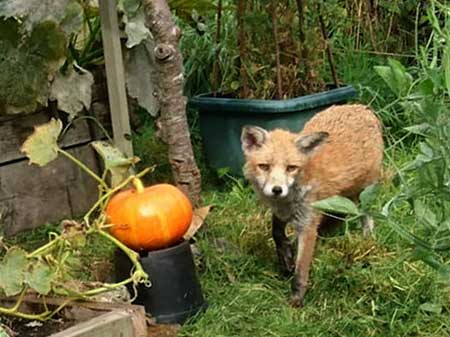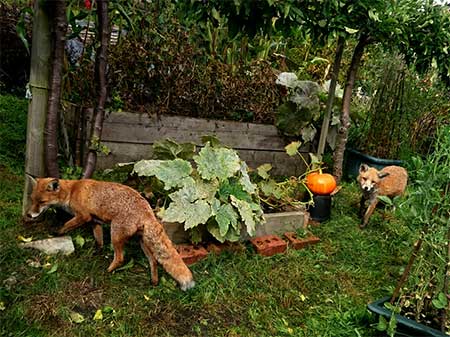Pest or guest of the month
|
This monthly selection offers a description of some of Warriston's beasty inhabitants and advice on how to live with them organically. Find more in our Pest or Guest archive |
October 2018 — Breaking news — Foxes caught red-pawed!
|
There have been reports of 'thieving foxes' at Warriston.
A month ago my neighbour north of my plot, told me the fox had been in his shed and taken his lunch. W'e laughed at this, but before the day was over the fox had been in my bag and taken my supper, some lamb's meat from Tesco. And last week it was in Nicola's plot with Christine's bag. The bag was rescued but the the jaffa cakes were no longer edible. Reporter: Mette, east side plot holder Foxes, as a species, have form. A quick google will reveal evidence of worldwide activity such as the removal of golf balls from putting greens, the interception of doorstep dairy deliveries, widespread skip and bin raids and, of course, their legendary chicken hunting escapades. From all accounts given by Warriston plot holders this year, there are only a couple of foxes living with us at the moment, maybe three. So, down on the usual population of about half a dozen. But this pair/trio are making up for the drop in numbers by being ever present and in thieving mood — cheeky, uncannily tame and healthier than their relatives from previous years, they scoot under sheds with plot holder's belongings — in the past six months alone they have been sighted running off with wellies, shoes, scarves and gloves. While they are very friendly and exciting to have around, do remember they are wild animals, so best to stay at a distance. And if you must feed these scavengers (which the RSPCA recommend you do not) junk or processed food will do them more harm than good. Best they keep the Warriston rats down instead. Foxes (sometimes half a dozen can be spotted at one time) are an accepted part of the Warriston scene. While they occasionally do damage to beds and seek refuge under sheds, they are fairly amicable and undemanding neighbours. We're lucky to have such beautiful, good natured companions on our plots. Some interesting fox facts: * Foxes first came to live in British cities in the 1930s, a process facilitated by the building of houses with medium-sized back gardens and allotments. These provide the diverse array of food, cover during the day, and den sites (hedges, scrub, compost heap, sheds) that foxes need to survive. * There are about 260,000 adult foxes in Britain (rural and urban). * Foxes are members of the dog family. A female fox is called a vixen, a male fox is a dog or a tod, and a young fox pup, kit or cub. A group of foxes is called a skulk or a leash. * Foxes can retract their claws like cats. Foxes also have vertical pupils like a cat. * Foxes are omnivorous, i.e. they will eat anything. In cities, the largest component of their diet is scavenged items such as meat, bones, bread and bird food. They also eat wild mammals (rats and mice), birds (mainly pigeons) and invertebrates (worms, beetles, cutworms (moth larvae) and adult craneflies (daddy-long-legs). A study in Bristol showed that insects make up 10% of a fox diet and earthworms about 6%. * In the city, foxes dig holes to hide extra food. When hungry they go to these earth larders for a snack. * Mange is a common disease of foxes and has caused fox population crashes around the world, including Britain and Scandinavia. Mange spreads effectively through rural and urban populations and can appear as a light (short term effects) or heavy (leading to death) infection. * Foxes can live to about 15 years in captivity but usually about 2 years in the wild. |
Warriston foxes at large. Photos: NR
Fox print. Photo: Wikimedia commons
Warriston foxes at large. Photos: NR
|






